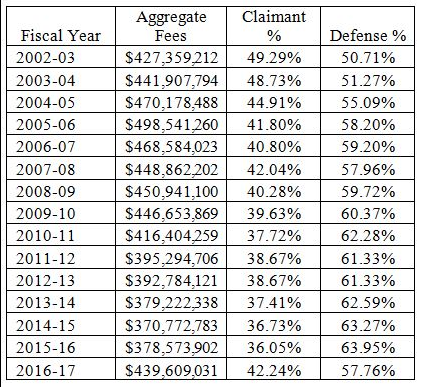Langham: Attorneys Fees in Florida Increased
Thursday, December 21, 2017 | 0
The Office of Judges of Compensation Claims is required by law to approve all attorneys' fees paid by, or on behalf of, an injured worker. There is no such specific requirement for the approval of fees paid by employer/carriers for their defense counsel representation.

Judge David Langham
Despite the absence of such specific requirement for defense fee approval, the broad language of Section 440.105(3)(b), Fla. Stat., arguably could require OJCC approval of defense attorneys’ fees. However, this statutory authority has historically not been interpreted to require approval of defense attorneys’ fees, although some claimants’ attorneys and groups have questioned this interpretation.
The OJCC has required insurance carriers to report their respective total annual expenditures for aggregate defense fees. Because these defense fee figures are reported in the aggregate, it is impossible to discern whether cost reimbursement to E/C attorneys has been included in the figures reported by the various carriers. Furthermore, this information regarding defense fees expended during the fiscal year does not provide any edification regarding the respective dates of accident involved in the cases in which those fees were paid during that fiscal year.
It is fair to say that the data collection process is imperfect. However, significant effort has been invested in assuring that the reported figures are as accurate as possible.
During 2016-17, a total of $439,609,031 was expended on combined claimant attorneys’ fees and defense attorneys’ fees (and perhaps defense “costs”) in the Florida worker’s compensation system. This represents a significant increase, about 16%, from the 2015-16 aggregate fee total.
Both claimant and defense fees decreased each year from 2010-11 through 2014-15, more significantly on the claimant side. Both figures increased in 2015-16, more significantly on the defense side. However the 2016-17 figures demonstrate a significant increase of 36.07% in claimant fees, with a more modest 5% increase in defense fees.
In the majority of years following 2002-03, claimant attorneys’ fees decreased. In 2015-16, that trend reversed for the first time since 2003-04. That increase was modest, and this office conjectured the 2015-16 figures could demonstrate an anomaly, but in light of Castellanos, more likely indicated of a trend change.
The 2016-17 figures demonstrate a sizable increase in claimant attorneys’ fees. The increase of 36% resulted in the highest claimant attorneys’ fee total ($185,676,766) since 2007-08 ($188,701,256).
The aggregate attorneys’ fees in Florida workers’ compensation are detailed in the chart below. This illustrates the total fees for both claimant and defense, and then provides the percentage that each make of the whole.
 This delineation was close to 50/50 in the early years of the comparison, but aggregate claimant fees decreased and employer/carrier fees first
This delineation was close to 50/50 in the early years of the comparison, but aggregate claimant fees decreased and employer/carrier fees first
increased markedly, and
then decreased
at more moderate pace.
A disparity between claimant and defense fees has developed. Since 2009-10,
the defense portion exceeded 60% for seven years. In 2015-16 the defense share was 63.95%, the highest since the 2003 statutory reforms. However, the significant 2016-17 increase in claimant attorneys’ fees impacted the percentage distribution that year, despite the fact that defense fees also increased in 2016-17.
In the 2012 annual report, this office first noted the inflation effect. Considering inflation over the last decade, this difference is more pronounced. According to the U.S. Inflation Calculator, the 2002-03 aggregate ($427,359,212), in 2017 dollars and adjusted for inflation, would have been $573,262,899. This is $133,653,868 more than the 2016-17 actual aggregate of $439,609,031.
Adjusted for inflation in 2017 dollars, aggregate attorneys’ fees in Florida workers’ compensation have decreased over $100 million in the last 14 years, despite the marked increase in claimant fees in 2016-17.
The claimant attorneys’ fee aggregate for 2014-15 marked the 11th consecutive decrease in claimant fees. The 2015-16 figures demonstrated a minimal increase in claimant fees, followed by a marked increase in claimant attorney fees (36.07%) in 2016-17. The increase is attributable to the hourly fee component of this aggregate.
Comparing 2015-16 to 2016-17 fees illustrates notable changes. The greatest portion of claimant attorneys’ fees are paid by injured workers when their claims are settled. In 2015-16, settlement fees accounted for 69% of the total claimant attorneys’ fees. The data for 2016-17 demonstrates that weight shifting, with settlement fees representing only 53% of the total claimant attorneys’ fees.
Although the total value of settlements in 2016-17 decreased slightly (-.38%), to $788,912,823 from $791,898,239, the settlement attorney fees increased (4.91%), from $94,428,009 to $99,066,123. Notably, the settlement attorney fees remained reasonably consistent over the last two years.
The notable increase in claimant attorneys’ fees is attributable mostly to hourly attorneys’ fees for litigation of issues. The aggregate of hourly attorneys’ fees increased in 2016-17 to $75,353,918, from $25,866,295 in 2015-16, an increase of almost $50 million, or 191% percent. In the same period, statutory fees in litigated issues decreased about 31%, from $16,285,382 to $11,256,762. Clearly, there is a trend suggested of increasing claimant attorneys’ fees in the wake of Castellanos and Miles.
It is noteworthy that defense fees remain the greater portion of the overall aggregate fees paid, at 57.76%. It is furthermore notable that the aggregate fees in 2016-17 remained less than the aggregate in 2003-04 and significantly lower than the inflation-adjusted 2003-04 aggregate.
Comparing the two elements — claimant and defense — separately, the claimant fees in 2016-17 remained below the corresponding total in 2002-03, while the defense fee element remained significantly higher in 2016-17 than the corresponding total in 2002-03, as illustrated in this chart:


In 2017, the Florida OJCC produced mid-year calculations of attorney fee data in January. That effort may be repeated in 2018 as questions continue regarding the trends and developments in fee volume.
David Langham is deputy chief judge of the Florida Office of Judges of Compensation Claims. This column is reprinted, with his permission, from his Florida Workers' Comp Adjudication blog.




Comments